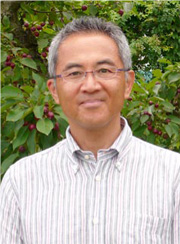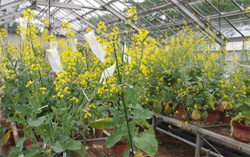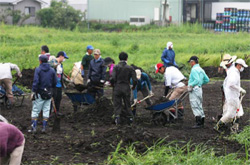Home > Highlighting JAPAN > Highlighting Japan SEPTEMBER 2011 > Farming a Recovery
Highlighting JAPAN
COVER STORY: A Rousing Summer in Tohoku
Farming a Recovery
Due to the salt damage from the tsunami caused by the Great East Japan Earthquake that struck on March 11, 2011, planting of traditional crops cannot be done on about 20,000 hectares of farmland along the Pacific coastline in Tohoku. The Rapeseed Project for Restoring Tsunami-Salt-Damaged Farmland mainly promoted by Tohoku University is an experiment in restoring this farmland. Shigeo Suemura spoke with the project leader, Professor Yutaka Nakai.

Professor Yutaka Nakai of Tohoku University
Credit: SHIGEO SUEMURA
Why did you start this project?
Yutaka Nakai: The Graduate School of Agricultural Science, Tohoku University in Sendai, Miyagi Prefecture, was damaged by the Great East Japan Earthquake. The damage was not so severe that buildings on the campus fell down, but water and electricity were not restored for almost two weeks. Once this infrastructure was restored, we began to search for ways we could help the region recover.
Since our specialty is agriculture, we thought we would help rebuild damaged farms. One of the laboratories of the graduate school has maintained a bank of around 800 varieties of Brassicaceae genes, the only such bank in the world. We thought there might be some way to make use of this.

Rapeseed blossoms—pictured here in a glasshouse at Tohoku University—are a symbol of spring in Japan, much like the cherry blossom. Boiled rapeseed plants are eaten as a spring vegetable.
Credit: YUTAKA NAKAI
Traditionally, salt-damaged farmland can be returned to normal by replacing the soil and water, but it takes a huge amount of money and time. Through this project we aim to allow farmers to earn money while restoring their farmland, without a period during which they cannot farm.
Can you give a more detailed explanation of what is being done?

Members of the Rapeseed Project for Restoring Tsunami-Salt-Damaged Farmland and other volunteers remove sludge carried by the tsunami to plant rapeseed, July 2011.
Credit: SHUSEI YAMADA
All the investigation results will be ready in a few months. Once these come out, rapeseed varieties that are suitable for the salt concentrations can be selected and other details can be settled.
This September, rapeseed seeds will be sowed in a 0.4-hectare rice field devastated by the tsunami in Wakabayashi Ward, Sendai. Before then though, the rubble and mud covering the soil needs to be removed. The cooperation of a large party of volunteers was acquired and work is underway.
Thanks to the combined efforts of people working toward the recovery of the affected areas, next spring the field will be full of blossoming rapeseed plants. We plan to carry out this project over the long term to restore farmland, and eventually build the community.
Have rapeseed plants been used before for dealing with salt damage?
Research is being done in some different countries. But there is no data regarding how much salt can be removed from the soil by cultivating rapeseed in an area that has actually suffered damage from a disaster. This experiment by the Rapeseed Project for Restoring Tsunami-Salt-Damaged Farmland will not just help in the recovery from the Great East Japan Earthquake, but should also be useful for dealing with salt damage all over the world.
In addition, rapeseed oil can be extracted from the rapeseed that is harvested. Rapeseed oil is used as carbon-neutral biodiesel fuel.
In this project, we will produce the biodiesel fuel as ecologically friendly energy.
© 2009 Cabinet Office, Government of Japan






